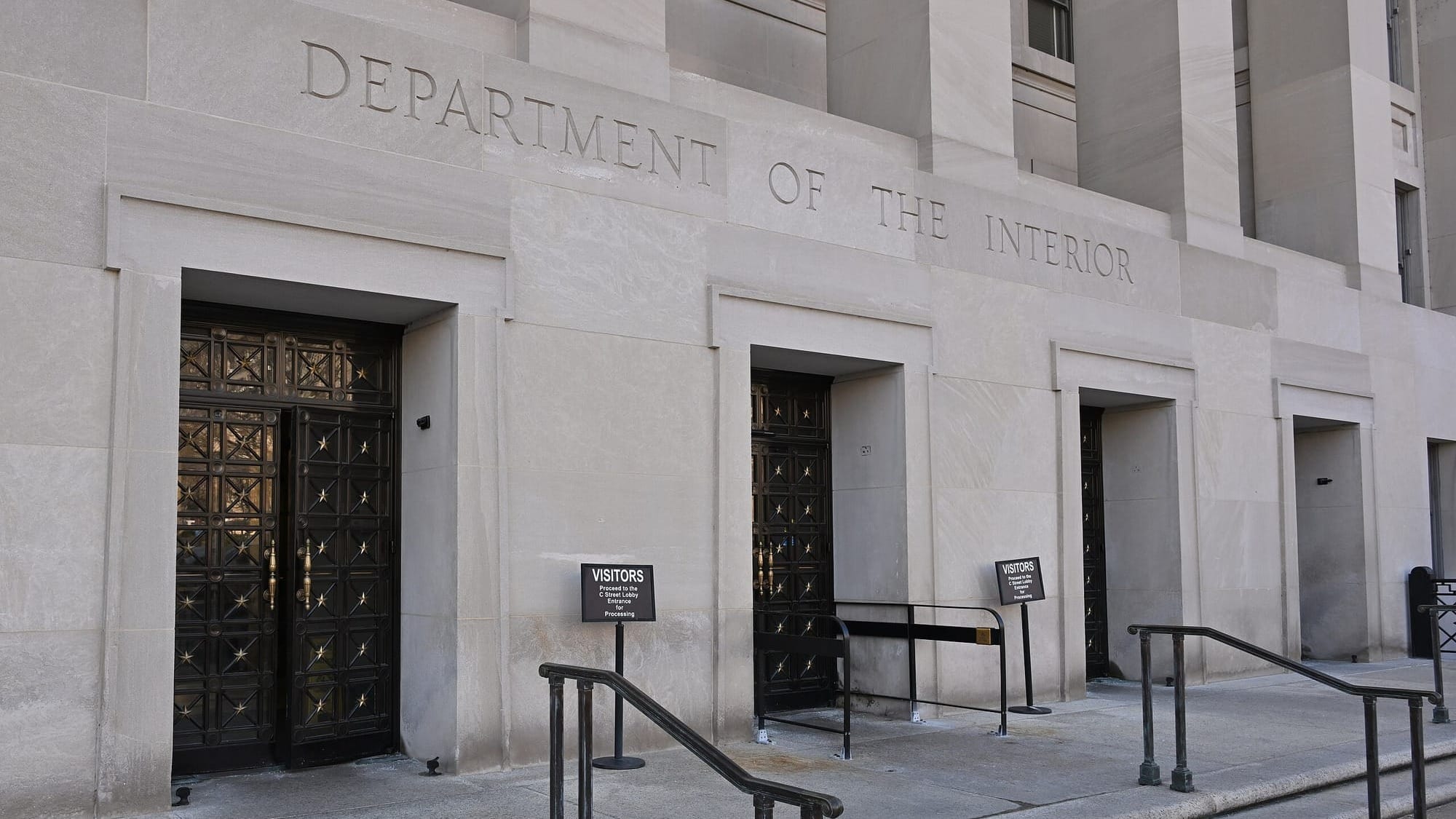The Values of the Administration
Or, the Fiscal Year 2026 President's budget request for Interior

To: Federal budget watchers
From: Next Interior
Subject: The values of the administration, the FY 2026 President's budget request for Interior
An analysis of the full FY 2026 President's budget request shows the values of the Trump administration for the Department of the Interior, regardless of what they may state.[1] In the following sections we get into some of the numbers and what they mean for the Department and people it serves. Here are three top-line take-aways:
- Conservation, recreation, science, and renewable energy are heavily targeted, with billions of dollars of proposed cuts. National parks, refuges, and public lands, including critical funding for States and Tribes; science on everything from water to natural hazards to climate and wildlife; and contributing to the Nation's energy transition...these are all in the crosshairs. This cannot be a budget that Teddy Roosevelt, whom the Secretary loves to invoke, would support.
- Fire gets most of the attention for increases, driven by the proposal to create a Wildland Fire Service at over $5 billion per year (probably ~$7 billion, depending on the details) that rolls together the fire work of Interior and the Department of Agriculture. While greater federal investment in wildland fire is warranted, expect that much of this is not increased investment, but moving funding around; we'll have to watch for other analyses to understand the details.
- Funding to support our trust obligations to Native Americans, Alaska Natives, and Native Hawaiians is slated for nearly $1 billion in requested cuts, to Tribes and their governments, to Indian education, wildlife and more. Remember, these are deep moral duties and they are embedded in the U.S. Constitution and US law.
If you depend on or care about the work of Interior, there are very few bright spots in this budget proposal. There is no evaluation of the benefits that Americans enjoy from Interior, just an obsession with cutting our institutions. It is a budget of unserious people, or at least of people who are not serious about governing and serving people efficient; at best they are serious about destroying government and serving narrow interests.
Background
The Constitution gives Congress the authority to establish the Federal government's budget and make appropriations in Article I. The Executive Branch is responsible for carrying out Congress's direction as laid out in Article II ("he shall take Care that the Laws be faithfully executed"). That said, the President can and should advise Congress on what it thinks the budget should look like; that's what a President's budget does every year to set out the administration's values. But at the end of the day, it is the job of the Executive Branch to expend the funding Congress appropriates.
So what does the FY 2026 budget request lay out for the Department of the Interior?
Key Elements
The full budget request is over 1,200 pages and filled with copious detail. This post cannot cover every single aspect of the FY 2026 budget proposal, even thought it is focused on Interior. But we can look at some of the highlights (= lowlights), presented in the context of the Department's mission. Methods and links to the data are provided at the end of the post.
Protect and manage the Nation’s natural resources and cultural heritage

The first clause of the Department's mission may be the most familiar to people because it covers things like parks and wildlife, energy and water, conservation and recreation.
Despite that, and despite the fact that Secretary Burgum regularly references the conservationist Teddy Roosevelt as a model, the administration is proposing about $1 billion in cuts to protecting and managing our Nation's resources ($938 million is one rough estimate). Here are just a few examples:
- Big cuts to parks, refuges, and public lands. Interior's land management agencies, the Bureau of Land Management (BLM), Fish and Wildlife Service (FWS), and the National Park Service (NPS), bear huge cuts both by absolute dollars and percentage. Lowlights include:
- Cutting $900 million and 4,000-5,000 staff from NPS. That means cuts to park rangers and interpreters who make family vacations possible. Loss of scientists, preservationists, and managers who keep our national treasures safe. Prepare longer lines, poor service, compromised facilities.
- Cutting $350-400 million (18-40%, depending on activity area) and between 1,300-2,300 staff from FWS. Biologists who save endangered species, managers who protect wildlife refuges, scientists who inform decisions, law enforcement who stop poaching and wildlife trafficking...all cut.
- Cutting BLM to the tune of $600 million (7-77%, depending on the activity area) and 600-1,200 people depending on the staffing baseline. $400M for conservation-related activities, like wildlife management and resource protection; even recreation management is proposed for a 63% cut. Our shared public lands, which they want to sell off anyways, will be worse off.
- Cuts to renewable energy. The most obvious cut is the proposal to terminate the Bureau of Ocean Energy Management's (BOEM) renewable energy work. Fossil fuels at BOEM get some attention but one of the few non-fire increases, with the conventional energy activity, is relatively small. The Bureau of Land Management's (BLM) energy and mineral work is cut, but the details of convention vs. renewable work are not clear.
- Steep cuts for water and power. Excluding supplemental funding from the Bipartisan Infrastructure Law and Inflation Reduction Act, the Bureau of Reclamation is slated for cuts on the order of $1.7 billion. (Note that FY 2025 funding levels were bumped up for a variety of reasons, but even compared to FY 2024 the cuts total $400 million.) The biggest losses are for water and energy management and development (~$700 million); fish and wildlife management also faces cuts on the order of $200 million.
- The budget and legislative proposal for a Wildland Fire Service at Interior is not possible to really assess at this point. Would greater coordination and resourcing be a benefit for federal wildland fire effort? Certainly. Will this proposal do that? Unclear...we will need to watch for further analyses.
Verdict: This budget proposal cannot reasonably be seen as advancing the first component of the Department's mission. People and the planet will lose.
Provide scientific and other information about those resources

Managing our public lands for conservation and recreation or for energy development and livestock, all in the face of climate change and other depends on sound science. The US Geological Survey (USGS) is Interior's principle science agency, but all bureaus have scientists who collect and analyze data to provide critical information for people everywhere to use in making decisions.
Science and related activities that are readily identified would lose at least $387M, with much of the focus on conservation- and climate-related science like the proposal to terminate the USGS Ecosystems Mission Area. Here are a few high-level examples:
- Terminates the USGS's Ecosystems Mission Area. This would be a massive loss for the country because it would mean the loss of:
- Climate Adaptation Science Centers, which provide critical science to help federal agencies, states, and local decision-makers adapt to changing climate, would be lost.
- Climate change is fundamentally change at multiple scales, spanning many jurisdictions, including interstate and international boundaries. As such, climate adaptation science must be a Federal responsibility: no state or city is in this alone, and the U.S. has an
- The Breeding Bird Survey and the Bird Banding Lab, which have been critical to understanding the lives, needs, and trends of America's birds. Check out the American Birding Association's run-down here.
- As with climate science, this is and should be an inherently federal obligation because the vast majority of our bird species migrate across state and international boundaries.
- The Cooperative Research Units, based out of universities across the country, provide critical natural resources science while they develop future natural-resource managers and researchers through graduate education in wildlife and fisheries sciences. Federal agencies, States, Tribes, private landowners, and innumerable scientists over the decades have benefited immensely from this common-sense investment that made the country stronger.
- Climate Adaptation Science Centers, which provide critical science to help federal agencies, states, and local decision-makers adapt to changing climate, would be lost.
- Cuts other science at USGS, and at FWS, NPS, and BLM, among others.
- USGS Natural Hazards, which provides science on every sort of natural hazard from earthquakes and volcanos to coastal and marine hazards, would get a $46 million (23%) cut. Hope you and your community don't need help preparing for and responding to these hazards.
- USGS Water Resources: $61 million (21%) cut. Understanding water seems important since it's essential for life.
- Even USGS Geology, Energy, and Minerals, whose science would have to underpin an "Energy Dominance" agenda is cut by $12 million (8%).
- FWS science support is cut by 25% ($8 million), but the cuts to NPS, BLM, and other bureaus' science capacity is buried in other activities. We'll need other analyses to really understand the depth of the damage.
Verdict: The budget proposal makes clear that the administration's rhetorical attacks on science are substantive. This is part-and-parcel with the broad attacks across the government's science endeavor.
Honor trust responsibilities or special commitments to American Indians, Alaska Natives, Native Hawaiians, and affiliated Island Communities

The U.S. Government has innumerable obligations to Indigenous Peoples, whether it's the constitutional or legal obligations to federally recognized Tribes, Alaska Natives, and Native Hawaiians, or the special obligations to the people of the Territories.
Nearly $1 billion in cuts to the Bureau of Indian Affairs and Bureau of Indian Education completely undercut these obligations. Note that the budget and appropriations for Indian Affairs is much more complex than the top-line and the few notes below; we will need to watch for additional, nuanced analyses to better understand the impacts. A few items that stand out:
- Public safety and justice would be cut by 25% ($140 million) despite the administration's "law and order" rhetoric.
- With cuts of $137 million (40%) to "638 contract" grants support costs, the goal of advancing self-governance and self-determination of Tribes as required under the Indian Self-Determination and Education Assistance Act of 1975 will be undermined.
- Over $500 million would be cut from BIE for school construction and education programs. The children and communities served by BIE schools will suffer accordingly.
- The budget authority for the Office of Insular Affairs would be cut by $300 million (38%). With international tensions and competition with east Asia, it seems like the strategic position of most Territories in the Pacific Ocean might warrant more investment, not less. (And I'll throw in a plug for the need to invest in data in and for the Territories!)
Verdict: The early assessment of the harms of this budget on Indian Country are supported now that we have more details.
Conclusion
As noted in the opening, if you depend on or care about the work of Interior, there are very few bright spots in this budget proposal. There are billions of dollars of cuts and everything from climate and nature to science to Tribes and their members will suffer as a result. All of that said, remember:
SO GET OUT THERE AND HELP US TAKE ACTION!

Methods
To better evaluate the FY 2026 President's budget request for Interior, the "obligations by program activity" portions of the "Program and Financing" tables for major portions of the Interior budget were manually extracted from the Appendix. (Note that this is neither a random sample of components nor a complete census of the tables; it is a set that was manageable on short notice.) An example of one of these tables, from BLM, is here:


In addition, the staffing tables for these entries were extracted; again, from BLM:

Given the nature and complexity of the data, no statistical analyses other than basic ratios and addition and subtraction were used. As such, there is no associated code. To aid in interpreting the broad strokes of the changes, a "category" was added to each row of the funding table to help summarize among conservation, recreation, energy, management, and other types of funding. This classification is a simplification of a very complex scenario - for example, is the largest chunk of NPS funding conservation or recreation when it is clearly both - but one we hope it provides some useful insights.
The data are available on Google Sheets and are archived at OSF, which will hold any revisions as well as the original data used in this post. The OSF repository also includes a copy of just the pages of the budget for Interior.
Footnotes
[1] Because funding is how you get things done–you need people and materials, which cost money–a budget proposal is a clear demonstration of values. As someone once said, "Don't tell me what you value, show me your budget, and I'll tell you what you value."

